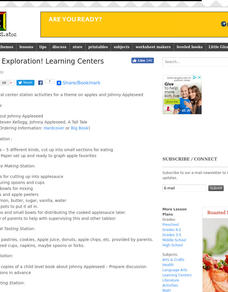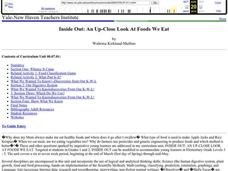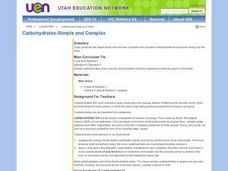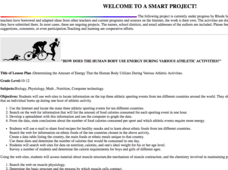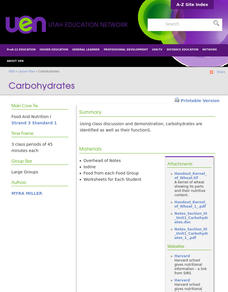Curated OER
Integrating Science and Literature: Life as We Knew It
Supplement your science units with science fiction novels!
Curated OER
Basic Vitamins: Water-Soluble and Fat-Soluble
Students examine vitamins and study their functions and food sources. They research what happens to vitamins when foods are overcooked. They prepare a microwaveable vegetable quiche.
Curated OER
Dietary Guidelines/Food Pyramid
Pupils study the recommended Dietary Guidelines for Americans and the Food Guide Pyramid. They discuss the foods they eat, watch a video about the Food Pyramid and examine actual foods portioned out into recommended serving sizes.
Curated OER
Your Role as a Taxpayer: Why Pay Taxes?
Students evaluate the basic rationale, nature, and consequences fo taxes. They describe why governments need taxes as revenue to provide goods and servicesin this series of activities.
Curated OER
Apple Exploration!
Students explore a variety of classroom stations about apples and Johnny Appleseed.
Curated OER
Inside Out: An Up-Close Look At Foods We Eat
Fourth graders identify the origins of meats and vegetables consumed by humans on a daily basis. They classify foods (meats, dairy products, grains...) and create a food pyramid.
Curated OER
Carbohydrates - Simple and Complex
Students examine simple and complex carbohydrates. They take notes and complete a worksheet. They also research cookbooks and find recipes which shows the simple and complex carbohydrate groups.
University of Rhode Island
How Does the Human Body Use Energy during Various Athletic Activities?
Students investigate how much energy is used during different athletic activities. They conduct Internet research to obtain information on the top three athletic sporting events from around the world, and calculate the calories burned...
Curated OER
Carbohydrates
Students listen to a lecture on carbohydrates focusing on the differences between complex and simple carbohydrates. They complete a demonstration and worksheet.
Curated OER
Break the Fast: The Start to Good Health
Students explore why eating a nutritious breakfast on a regular basis is important.
PBS
Pbs Learning Media: What's in That Box of Cookies, Anyway?
In this video segment from TV 411, learn how to read nutrition labels on food containers and calculate the calorie content of different serving amounts.
Concord Consortium
Concord Consortium: National Health and Nutrition Examination Survey Data Portal
Access and explore large datasets from the National Health and Nutrition Examination Survey (NHANES, 2003). Working with large datasets that emphasize exploration, finding patterns, and modeling is an essential first step in becoming...
Alabama Learning Exchange
Alex: Marathon Math
This unit on sequences and series is intended to help students make the connection from math to real life situations. Developing a marathon training program for a beginner runner is one simple way that students may use patterns in real...
PBS
Pbs Kids Afterschool Adventure!: Operation: Brown Bag Activity Plan
It's time for lunch! In this week-long adventure, children will explore numbers and counting in the context of healthy eating. They will learn about the five food groups and create a healthy lunch using foods from each food group. Each...
PBS
Pbs Learning Media: Sesame Street
Do you know how to get to Sesame Street? This collection is designed to engage preschoolers in everyday learning by teaching core skills in Math, Literacy, STEM, and Social and Emotional Development. Here you'll find hundreds of videos,...
PBS
Pbs Learning Media: Living With Diabetes
A patient discusses diabetes and how he manages his carbohydrate intake in this video segment from TV 411.
Better Lesson
Better Lesson: Sugary Surprises
Grams are a useful measurement in determining nutritional content of food.
PE Central
Pe Central: Pe Lesson Ideas: How Far to Mount Katahdin
Organized into 5 parts, this lesson combines physical activity with academic subjects including math, health, and geography. In part I, students calculate how many steps it would take to complete the Appalachian Trail. In parts II and...






